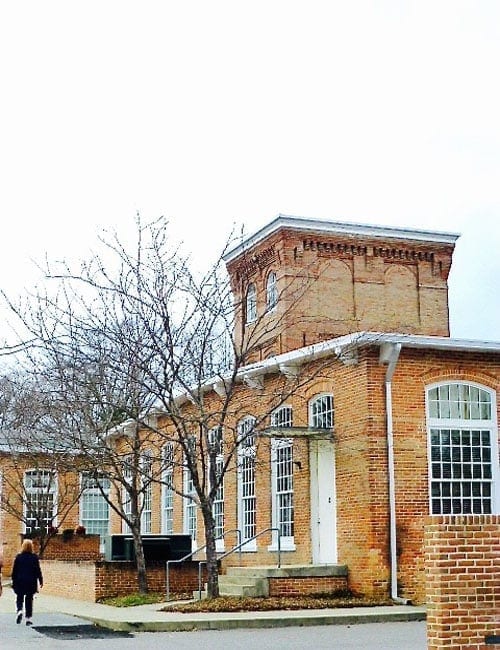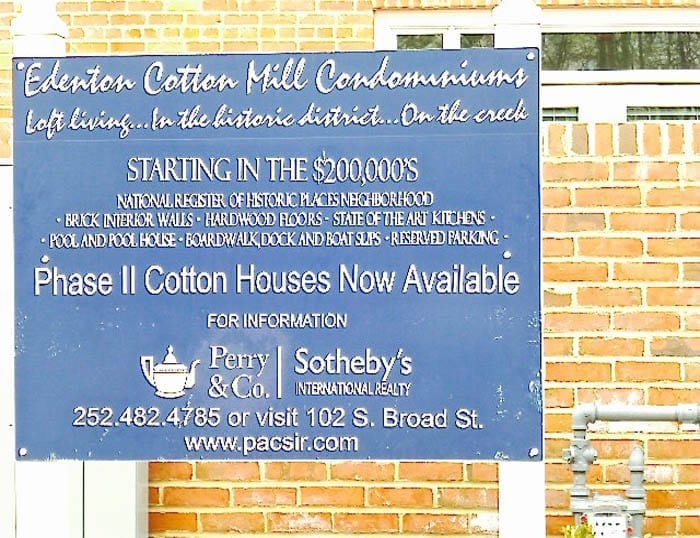Re-purposing a 1900s Cotton Mill for the 21st Century, in Edenton, NC

How lucky could I be? I had read about the Cotton Mill conversion and asked Eleanor if she would put it on our itinerary when I visited her in Edenton, NC. Little did I know that she’d ask her realtor, Anne Perry of Sotheby’s, to be our personal guide. Anne had been involved in the Cotton Mill Project since its beginning and knew every detail about it. Her family has lived in Edenton for several generations and she is intimate with the history of the town as well as the history of its citizens.
Climbing into Anne’s car, Eleanor and I were first taken on an overview tour of Edenton who told us the history of the city and explained the changes that had taken place as well how few changes have in fact taken place in the past century. We looked at the harbor, with its boats rocking in the water, and learned that in addition to pirates being very active there in the early days, much history was been written in its waters. This was once a thriving port, collecting big money through its customs house. And of course, because it was a seafaring community, there was also boat building. Anne seemed to be friends with everyone and knew who lived in each house.

Arriving at the Cotton Mill was “deja vu” — I’d already seen pictures but had no idea of its grandeur and scale until I saw the buildings. Completed in 1900, it was a genuine working Cotton Mill, making an important contribution to the local economy and employing many workers. It seemed a disaster when due to the economic downturn of the area it closed operations in 1995. But when it was donated to Preservation North Carolina, an organization dedicated to the preservation of historic sites and buildings, the building received significant tax advantages which came in handy during the refurbishment and repurposing.

The original mill is an Italianate Revival brick industrial complex, a style popular at the turn of the century for mills in the Carolinas. The building is said to have been built using one million bricks that were made on site.
Anne said the conversion project was awarded to Clearscapes of Raleigh, NC, who she knows personally and who are experienced architects in the field o warehouse and factory conversions. Under Clearscape’s supervision, the work was executed with great awareness of the building’s heritage, preserving as many of the architectural walls, joists, beams and details as possible — even the original cotton mill scale from the factory has been incorporated into the interior design as a feature. The color of the bricks is a warm gold, and the exposed walls have been retained for the interiors giving it a rustic, industrial feel. The ceilings are fifteen feet high with exposed beams and joists and the original floors are a warm, weathered maple.
There are approximately one hundred and eighty segmented arched windows that are an important architectural feature of the design, each twelve feet high and five feet wide. In the 1960s, when air conditioning was added to the structure, several windows were removed and the open space was bricked up. For the restoration, the bricked up window spaces were re-opened and new windows were ordered, exact replicas of the original ones. As each window opening was slightly different in size, they had to be custom made, adding significantly to the the costs. But the result is elegant.

Anne walked us through a separate building alongside the mill that had previously been used to store raw cotton. It is presently being converted into five single story condos, ideal for part time residents or homeowners wanting to downsize to something quite elegant. There are also seventy cottages in the cotton mill village on the same development, originally built to house the managers, factory workers and their families. When the mill closed down, an effort was made to sell these mostly one and two bedroom houses. But with very little demand at the time, they sold for $20,000 to $25,000 each!
Now twenty years later, these charming cottages have been restored, updated and are worth $250,000, if you can find one for sale! I had the opportunity to stay in one and found it quite cozy.
Where once machines had hummed and clicked spinning cotton, there are now thirty condos, each one a different configuration and each one “disciplined” by the original construction and design. We were able to see the interiors of the condos and whether furnished in modern, traditional or eclectic style, they are dramatic inviting living spaces with the large windows letting in lots of light and sunshine with a vista of the outdoors that brings new life to this historic complex. Abutting the Edenton Bay and a couple of blocks from town, living at an address that is now on the National Register of Historic Homes — what a unique experience that can only be shared by a limited number of homeowners. Lucky people!!
This was a most generous and unique tour by Anne Perry, with many details and insights to how this groundbreaking development had come about, working through many hurdles, getting endless approvals and permits before the project was completed. How fortunate that in the correct hands these beautiful old buildings have been saved and re-purposed for future generations to enjoy.
Want Phyl on the Go delivered to your inbox? Sign up for her mailing list here.

